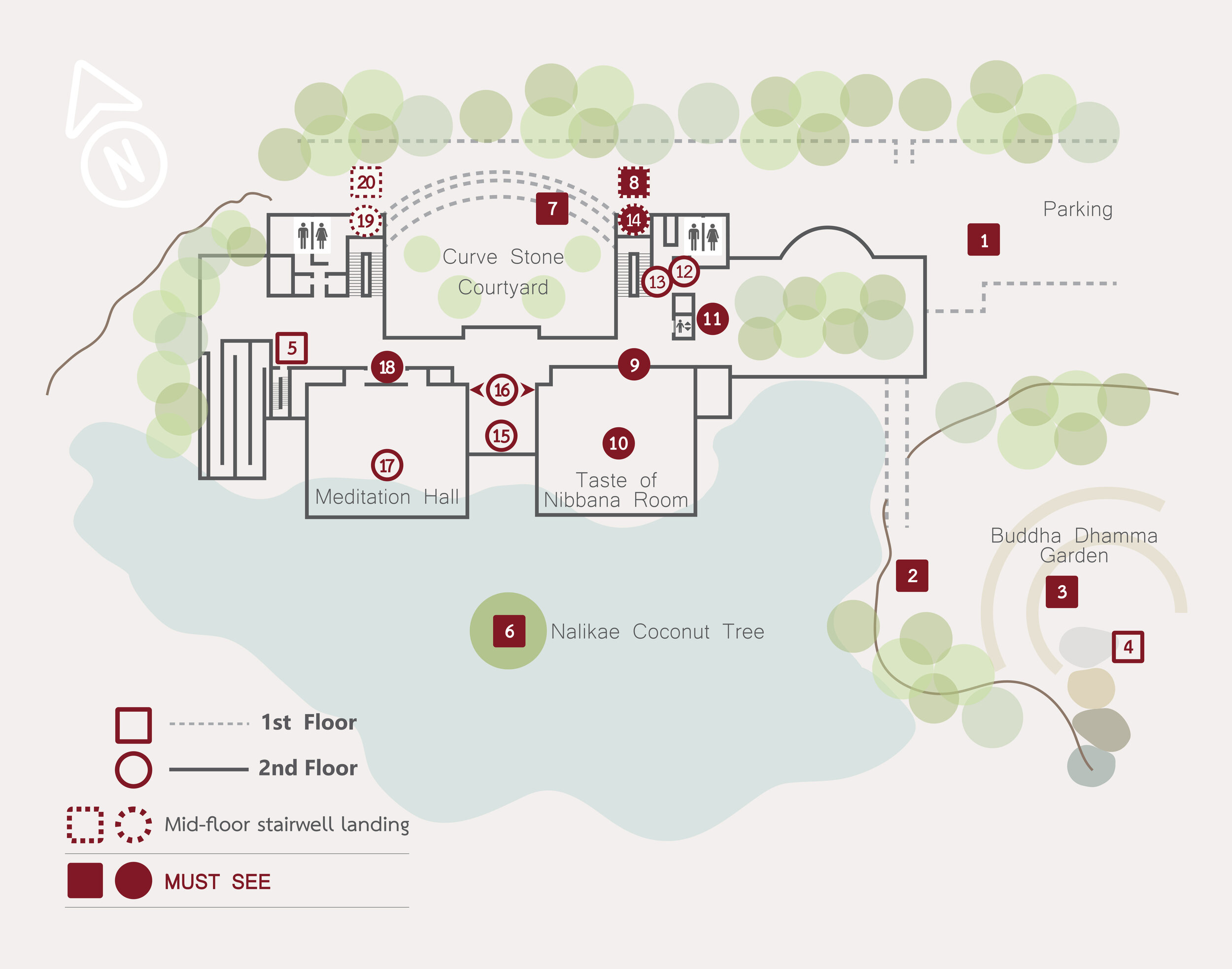Turtle Whiskers, Rabbit Antlers, and Frog Horn
Metaphors for non-self and emptiness
The two walls framing the open-air Owata Hall display a replica of an ancient Thai painting series depicting the Buddha’s core teaching, The Four Nobel Truths, and how the realization of non-self and emptiness brings about suffering’s defeat.
Suffering and its origin
The story begins on the left wall (upper image above) with a circle containing birds trapped in a giant spider web. Their struggle is that of all beings, ensnared by the power of Mara the Tempter, the Destroyer, the Demon obstructing their liberation from suffering.
Mara appears in four variants: defilements in the form of greed, anger and delusion; illness and aging; death and preventing the further cultivation of merit; and as a deity seducing one into clinging to all sensual pleasures.
Mara can be seen here as savage giants, enchanting angels, beautiful women, handsome men, and even respected rishis. Mara hurts, tortures, and deludes human beings who lack wisdom, trapping them in misery.
Under the influence of the six sense-bases (eyes, ears, nose, tongue, body, and mind), beings suffer in never-ending cycles or rebirths.
The root cause of this persistent suffering is Ignorance, specifically ignorance of how suffering arises through a twelve-linked process known as Dependent Origination or Paticcasamuppada.
Ignorance is represented in the story by the Phnom Chakra Mountain. Dependent Origination is represented by a discus divided into twelve sections, each containing a human being. This is displayed on the right wall (lower image above).
The end of suffering
The story continues with devas (celestial beings) bringing Dhamma, the Truth of Nature, to humans as a refuge. Three majestic beasts represent the Triple Gem: the Buddha, the Dhamma and the Sangha. They carry on their backs the Discourses (suttas), the Discipline (vinaya), and Ultimate Truth (paramattha).
Beneath these beasts, a deva transforms a skeleton into a child. The child is sent to learn from three sages, who also represent the Triple Gem. The sages gift to the child a dagger, a bow made from rabbit antlers, string made from turtle whiskers, and an arrow made from a frog horn. These weapons are a metaphor for the realization of non-self and emptiness, a true understanding of which can destroy one’s defilements and end one’s suffering.
The path leading to the end of suffering
The child is now equipped with the right weapons and the knowledge of how to use them, which together symbolize following the noble path leading to the ultimate removal of defilements.
The child transforms into three lords: the Buddha Lord, the Dhamma Lord, and the Sangha Lord. The Buddha Lord shoots an arrow that changes into a garuda (legendary bird king), who devours nagas (legendary serpent kings) that entrap humans and animals. The Dhamma Lord thrusts a dagger into the heart of Mara, freeing all beings from delusion. The Sangha Lord throws a discus at an eagle, severing its wings and smashing it to bits, symbolizing the extinguishing of Mara and all unwholesomeness. The nagas, Mara, eagle, and other evil beings symbolize defilements in the mind, which can be eradicated by following the Noble Eightfold Path.
The Noble Eightfold Path can be divided into the Threefold Training: Morality, Concentration and Wisdom. This is depicted here as three children standing atop one another. They are attempting to reach the branches of a tropical magnolia tree to pluck its flowers of Nibbana, so as to achieve the complete liberation from suffering.
The painting’s final scene shows a temple with three jewels inside, symbolizing the fruits of Nibbana, being worshipped by devas and humans alike.



